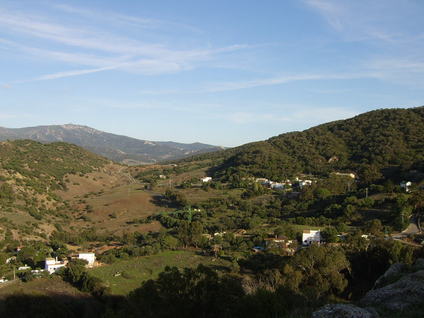
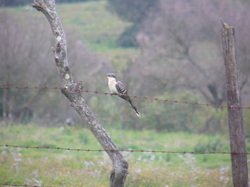

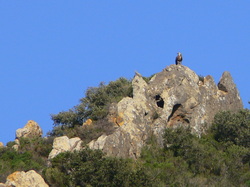
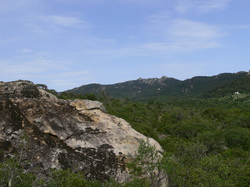
| Birding Cadiz Province |
|
 Entrance to the Molinos valley from Alcala The small village of Alcalá de los Gazules sits high on a small hill above the A381 behind which looms the wooded hills and crags of the Alcornocales. As the A 2304 skirts round the village a minor road (CA 6201) strikes off to the east. This takes you down the Molinos valley to the small hamlet, and that’s a generous use of the word, of Patrite which forms a lose cluster of houses at the valley. A plan, during the earlier years Franco’s dictatorship, to push the road all the way to Jimena (c17km through the park) was mercifully abandoned thus preserving the wild landscape. This was a mercy not just for the landscape, but also for those earmarked to build it as, like many roads of that era, it was to be built by forced labour using Republican prisoners. Although close by the village, a lip at the start of the valley means that once you’re a few hundred metres along it you can see scarcely any signs of civilization lending the place a surprisingly isolated feel.  Record shot of Great-spotted Cuckoo The start of the valley (a) is often a good spot to look out for Black-eared Wheatear as a pair usually breeds here. The road quickly drops down into the valley which then opens out as the road heads, arrow straight, towards Patrite. The telegraph wires here frequently provide a place for passing Bee-eaters to rest and for hunting Woodchat Shrike to use as a vantage point. In winter Woodchats may be replaced by Iberian Grey Shrike. About 3km along the road there’s a rough track (b), to your left, also bordered by telegraph wires which again provide perches for passing birds. With virtually no traffic, this is a better place to stop and look than the main road (although its hardly very busy). This is another site for breeding Black-eared Wheatear whilst I’ve also had passing Tawny Pipits and Great-spotted Cuckoos here. The whole valley seems to funnel migrants with Black and White Storks regularly passing over in good numbers and rarities like Rock Sparrow occasionally turning up. After just over a kilometre the track is closed off by gates and apparently private, but it’s worth exploring to this point as the stream, now shaded by trees, may attract small birds.  Griffons in the Molinos valley As with anywhere in Spain, the skies should be regularly scanned for raptors, but with a large roost of vultures further up the valley it’s not unusual to see a good sized flock of Griffon Vultures here although seeing them drop to the ground requires rather more luck. In late spring the birds often move out of roost at c10:00 AM. Any soaring flock should be checked carefully as Egyptian Vultures are regular enough to suggest that they might well breed not too far away. Booted and Short-toed Eagles too are frequently to be found here. Keeping you eyes closer to the ground shouldn’t be neglected either as the small stream lined with bushes that passes under the road near the campsite often attracts smaller birds; Melodious and Sardinian Warblers, Goldfinch and Serin. Look carefully at the latter during winter and on passage as Siskin also occur. The campsite makes a pleasant place to stay and has a resident Barn Owl. Little Owls are common and it’s hard to believe that the surrounding hills don’t harbour Eagle Owl. I’ve looked for them without luck, but have seen them in what appears less favourable habitat along the A381 near the village.  A Griffon Vulture sunning itself at the start of the valley At the far end of the road it degenerates into a rough track and finally a gated footpath (sendero) which takes you c1.5 km into the hills and to the last of several ruined molinos (water mills). After the Llanos de Libar (Grazalema) this walk is the one that most impresses my visitors. Following rain the rocky crags here often host Griffons which strike an impressive heraldic pose with wings open as the dry off in the sun. Fittingly, the rocks here may also have Blue Rock Thrush. Crested Lark has been the default lark thus far, but look carefully as I’ve had Thekla in rockier fields near the footpath (although they’re more frequent much further along the path). This, and other open areas, may also have Cirl Bunting. After skirting the crags on your left, the path climbs as it cuts diagonally across a thistle rich pasture towards the hills. As it snakes along the flank of the hill the path seems to reach a dead end, but continue onwards and where you seem to reach a blank rock wall the path suddenly takes a dogleg left and then right. This is a bit of a scramble but easily negotiable with care. Here the path squeezes (c) between jutting vertical rock strata to plunge back into what seems like a hidden valley. Although you may have had them already, the light woodland here is particularly good for various small passerines. Long-tailed Tits here are of the southern race A. c. irbii – named after the pioneering British ornithologist of the area, Lt-Colonel Irby. Firecrest are common as are both Bonelli’s Warbler and Iberian Chiffchaff. The latter has a song so distinct from the more familiar chiff-chaff-chiff-chaff of northern birds that it’s a surprise that the species so long languished as a ‘mere’ subspecies. A slightly drunken shief shief shief shief wee-wee-wee-wee-wee sweet sweet sweet it has a different cadence and a slightly Willow Warbler like trill.  The far end of the Molinos valley As you continue scan the distant (and not so distant) crags for roosting Griffons although you have as good a chance of seeing birds drifting low to see what you’re about. It’s not unusual to see 200-300 birds although upwards of 600 birds are possible. Check them very carefully as Spain’s second Ruppell’s Vulture occurred within the ‘parish’ making this as good a site as anywhere to look for this elusive visitor. Look out too for Spanish Ibex. Peregrines breed in the vicinity and, although rarer, Bonelli’s Eagle are regular. With Lesser Kestrels dominating in Alcala itself, these crags more often have Common Kestrel. Finally you reach, after a pleasant walk, a ruined mill (d) which makes a great picnicking spot. Technically, an old drover’s road continues all the way to Jimena (c15km) but a gate here marks the end of this sendero. You can continue over the stream and up towards the distant ‘forest road’ (Carrel Picacho-Piguera) just visible through the trees. The upper slopes here have Thekla Lark and are an even better viewpoint from which to search for raptors.
1 Comment
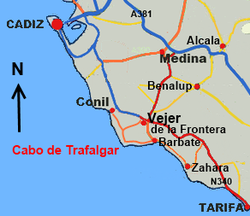 To British ears there can be few place names so redolent of past naval glories as Trafalgar nor one quite so British in celebrating victory in the midst of tragedy. Cabo de Trafalgar was one of the few historic sites that, back in the late 1960s, I managed to visit on my first trip to Spain. This was somewhat ironic since there wasn’t actually anything to see there! The Spanish, of course, were on the losing side in that battle albeit not entirely willingly so. Rather sportingly, though, in 2005 they erected a small monument there to mark the bicentenary of the battle. Naturally my ornitho-philistine friends only allowed me to visit the site because there was a chance of some good birds – principally Cory’s Shearwater and Audouin’s Gull. Unfortunately, it was a scorching hot August day, the sea was flat calm and sharing one ‘scope between five wasn’t exactly ideal so we dipped on both species. It took me over 15 years to catch up with Cory’s Shearwater (in Cornwall) and another twenty to see Audouin’s! 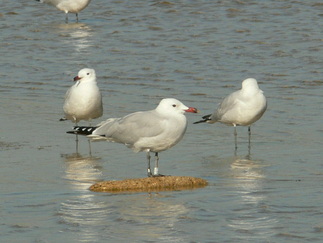 Cabo de Trafalgar doesn't project that far into the sea and is no great height, but situated on a 'corner' (see map) it can be good for seabirds and visible migration. Having failed so miserably previously, on my returm a few years ago I was pleased to find a large flock of gulls loafing in the shallow sandy, tidal pools beside the tombola linking the rocky cape to the mainland. A quick scan with the binoculars quickly revealed a small number of remarkably handsome Audouin’s. Whilst I hadn’t been too worried about ID issues, I was surprised by how striking the adults were with bold yellow-tipped, black banded dark scarlet bills, pale grey backs and delicate pale ashy underparts. The juveniles were less distinctive, but clearly duskier than similar species. Since then, except when they are dry or too disturbed by tourists, I have found these pools a good place to see the species. There’s usually a supporting cast of Mediterranean Gulls, Kentish Plover, Sanderling and whatever waders might be passing. 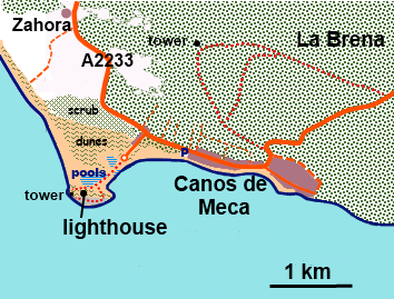 Unfortunately, I’ve not often visited the area in late September/October, but when I have I have witnessed the most extraordinary ‘visible migration’. ‘Vis. mig.-ing’ is not something I’ve always enjoyed in the UK. A good session, as often as not, means it’s windy, chilly or both and birds often fly over fast and high. Hence a good knowledge of calls is often being vital for accurate ID. In Spain birds can still go over at height and calls can mystify even more, but at least it’s often warm and dry. Standing by the lighthouse as wave after wave of larks, finches, pipits & finches pass overhead is an extraordinary experience. It can also be somewhat surprising one as seeing birds like Chaffinches and Siskins passing over isn’t the expected Mediterranean experience. Hirundines frequently not so much ‘pass over’ as skirt round you with more familiar fare being supplemented by Red-rumped Swallows and Crag Martins – many at arm’s length. Whilst not an ideal place to look for raptor migration even the dullest ‘seawatch’ here can be enlivened by the arrival of wind blown Black or White Storks, Lesser Kestrels, harriers or eagles. (Departing broad winged birds are more circumspect about leaving Europe here). 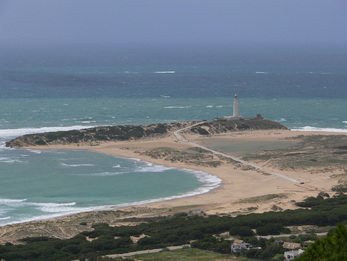 Seawatching, arguably, has the most potential for the unexpected here. Trafalgar is a somewhat blunt projection into the Bay of Cadiz, but a less public one than offered by Cadiz itself or Chipiona to the north. Watching here can be rather exposed although the old watch tower may offer some shelter in the right conditions. Watching from a car off Conil, where there are plenty of places to pull off or even grab a coffee, may be more sheltered and convenient, but the lack height and that extra ‘projection may make some difference. So it’s Trafalgar that I’ve most often gone for seabirds despite the lack of shelter. Gannets, Balearic and Cory’s Shearwaters are regular, but it may require a sharper eye than mine to pick out Yelkouan or Scopoli’s Shearwater. The latter may even require access to a small boat and SLR camera! Great Skua are also regular, but with ‘southern’ members of this complex being found off Senegal and elsewhere this is another area where a boat trip, supported by digital photography, may be needed. Arctic Skua (which I’ve seen) and presumably Pomerine Skua (which I’ve not) are probably regular here. Given that ‘seawatching’ doesn’t seem a popular branch of birding in Spain and some of the more surprising revelations made by its popularity in the UK, I wonder what surprises may be in store if an enterprising team watched Trafalgar in ideal conditions (and what are they?). The recent discovery of small numbers of Wilson’s Petrel in the Straits of Gibraltar in late summer may suggest they could be seen here in strong westerly gales. Perhaps even Bulwer’s Petrel or Little Shearwater can’t be discounted as outside possibilities in the right circumstances. 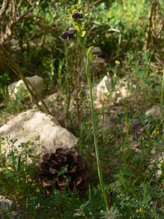 Beyond Canos de Mecca towards Barbate stand the pinewoods of La Brena. Birdlife in these woods is a little sparse (though good for Serin, Short-toed Treecreeper, etc) and, in season, migrants. However, in early spring (February onwards) the woods may have huge numbers of orchids – mainly (perhaps exclusively) Ophrys or ‘bee orchids’. To be honest I know little about orchids so my identification may be awry with some. I’m confident that many are Mirror Orchids and that some, far fewer in number, are Sombre Bee Orchids. The remainder more closely resemble ‘our’ Bee Orchid in the UK, and some indeed may be that species, but I’ve tentatively identified them as Sawfly Orchid. Sadly the nearby cliffs are no longer home to cliff nesting egrets. Yet Cabo de Trafalgar doesn’t always offer some sort of birding idyll. The conditions that create the best vis. mig. also attracts half a dozen or more bird trappers to the scrub to the north. Meanwhile the local authorities seem bent on doing their utmost to discourage visitors. It was once possible to drive just beyond the small roundabout (see map) to park along the track within a few hundred metres of the lighthouse. However, this was stopped a few years ago. For a while it remained possible to park off the road just after the turning off the A2233. However, wooden bollards have now mushroomed up here and parking is now limited to private car parks serving several small restaurants. Worse, parking off the A2233 itself now seems discouraged so you might be faced with a trek of a kilometre or more to get to the headland. Quite why the local police are so keen to stop parking here I’m unsure. However, I suspect that it might be something to do with a conflict between those who want the area’s ‘hippy’ image to continue and those who want to develop a couple of large hotels in the area and drive the place up market.
|
About me ...Hi I'm John Cantelo. I've been birding seriously since the 1960s when I met up with some like minded folks (all of us are still birding!) at Taunton's School in Southampton. I have lived in Kent , where I taught History and Sociology, since the late 1970s. In that time I've served on the committees of both my local RSPB group and the county ornithological society (KOS). I have also worked as a part-time field teacher for the RSPB at Dungeness. Having retired I now spend as much time as possible in Alcala de los Gazules in SW Spain. When I'm not birding I edit books for the Crossbill Guides series. CategoriesArchives
May 2023
|